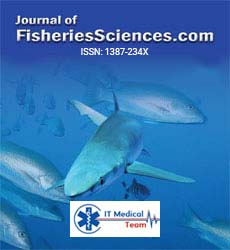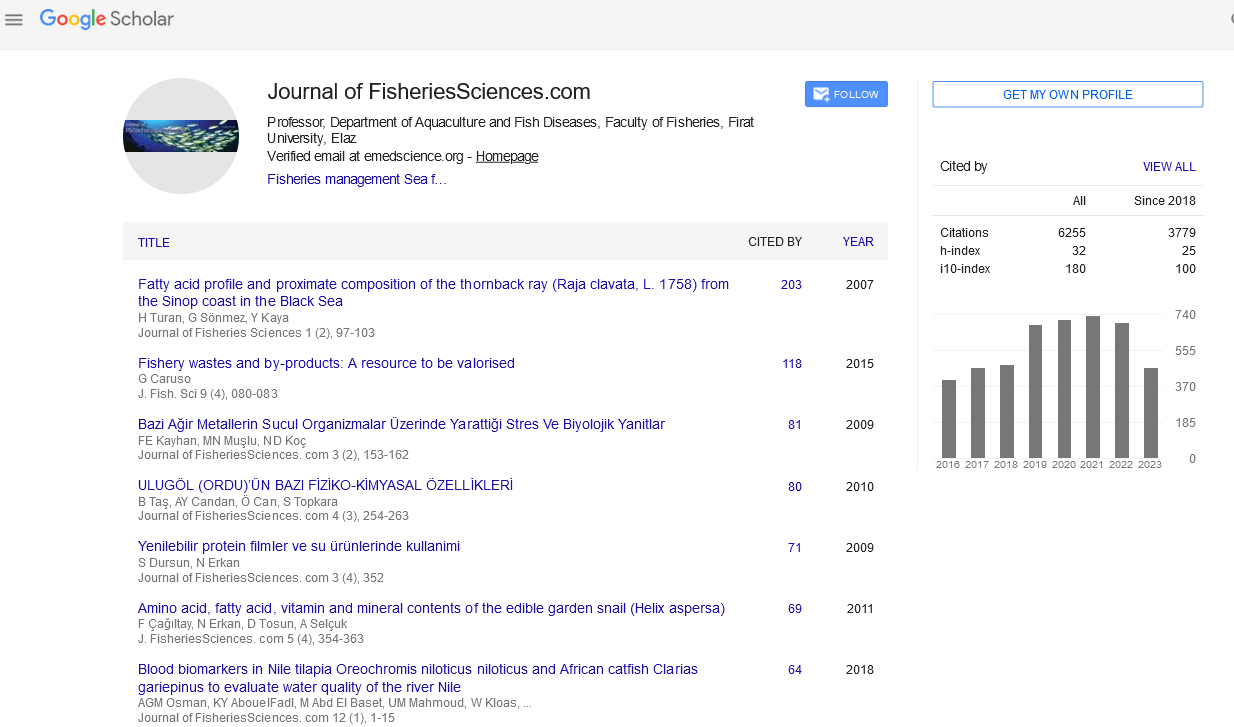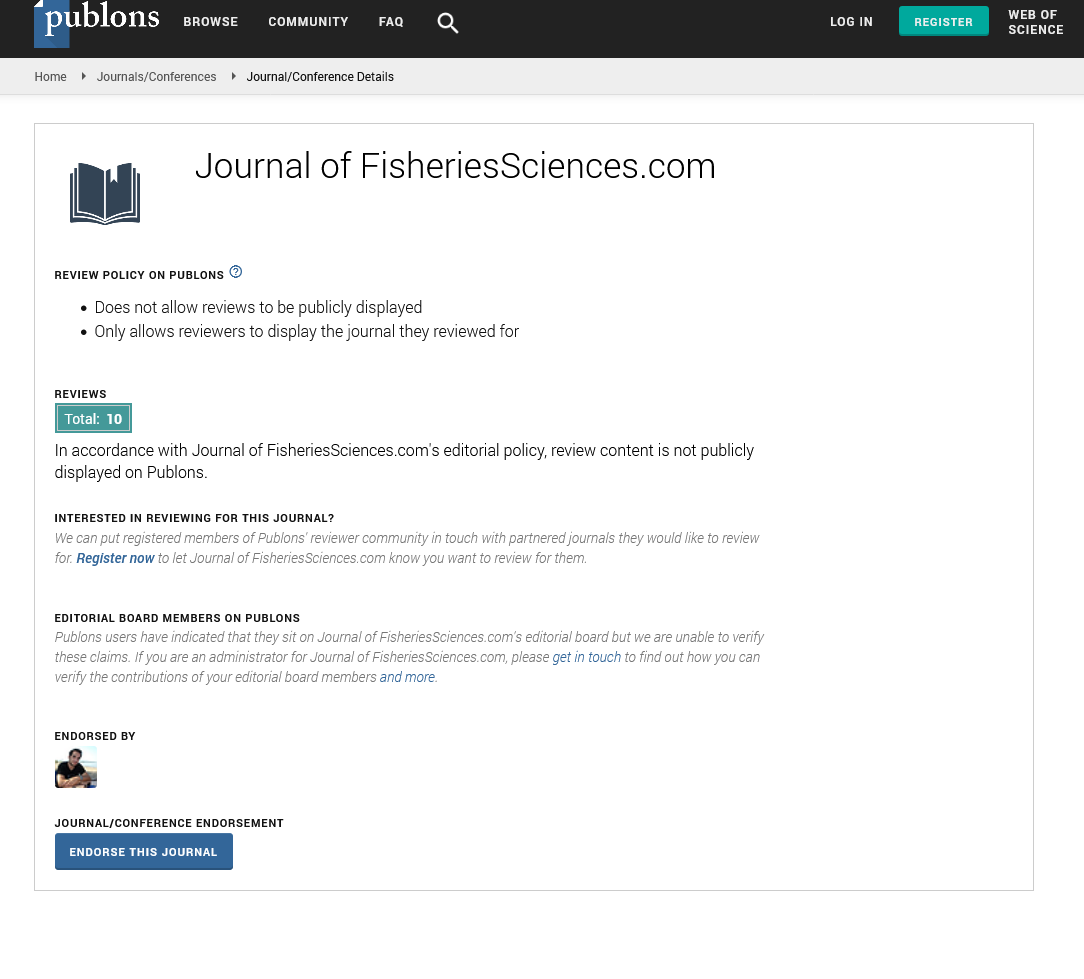Editorial - (2022) Volume 16, Issue 6
Aquaculture and its Importance
Ishmael Kosamu*
Department of Fisheries, Malawi
*Correspondence:
Ishmael Kosamu, Department of Fisheries,
Malawi,
Email:
Received: 01-Jun-2022, Manuscript No. ipfs-21-9421;
Editor assigned: 04-Jun-2022, Pre QC No. ipfs-21-9421 (PQ);
Reviewed: 20-Jun-2022, QC No. ipfs-21-9421;
Revised: 22-Jun-2022, Manuscript No. ipfs-21-9421 (R);
Published:
29-Jun-2022, DOI: 10.36648/1307-234X.22.16.97
Introduction
Aquaculture (also well-known as aquafarming) is the farming
of fish, crustaceans, mollusks, aquatic plants, algae, and other
creatures (less usually spelled aquiculture). Aquaculture involves
the cultivation of freshwater and saltwater populations under
controlled settings, as opposed to commercial fishing, which entails
the capture of wild fish. The Food and Agriculture Organization
(FAO) defines aquaculture as "the farming of aquatic creatures
such as fis, mollusks, crabs, and aquatic plants [1]." Efficiencies on
farms can be improved with some sort of intervention. Stocking
regularly, feeding, and warding off predators are some examples
of proper management. Individual or corporate ownership of
the stock being grown is also implied by farming." Aquaculture
additionally well-known as aquafarming, is that the farming of
fish, crustaceans, mollusks, aquatic plants, algae, and alternative
organisms [2]. Aquaculture involves cultivating freshwater and
saltwater inhabitants under controlled conditions, and can be
contrasted with profitable fishing, which is the harvesting of
wild fish. In keeping with the Food and Agriculture Organization
(FAO), cultivation "is understood to mean the farming of aquatic
organisms as well as fish, molluscs, crustaceans and aquatic plants.
Farming implies some sort of intervention within the rearing
method to reinforce production, like regular stocking, feeding,
protection from predators, etc. Farming also implies individual or
corporate ownership of the stock being cultivated." Fish farming,
shrimp farming, oyster farming, mariculture, algaculture (such as
seaweed farming), and ornamental fish farming are all examples
of aquaculture. Mariculture and integrated aquaculture are two
aquacultural practises. A variety of factors can have an impact
on aquaculture welfare, including stocking levels, behaviour ral
interactions, sickness, and parasitism. One of the most difficult
aspects of pinpointing the reason of diminished welfare is that
these factors are frequently interconnected and influence each
other at various periods. The carrying capacity of the supplied
environment and the amount of individual space required by the
fish, which is species specific, are frequently used to establish
optimal stocking density. Although behavioural interactions such
as shoaling may indicate that high stocking densities are helpful
to some species, high stocking densities may be problematic in
many cultivated species. Crowding can limit natural swimming
behaviour while also increasing aggressive and competitive
behaviours such cannibalism, feed competition, territoriality, and
dominance/subordination hierarchies. This raises the possibility
of tissue damage owing to abrasion from fish-to-fish or fish-to cage contact. Fish may have decreases in food intake and food processing efficiency. Furthermore, excessive stocking densities
can result in insufficient water flow, resulting in insufficient
oxygen supply and waste product disposal. Dissolved oxygen
is required for fish respiration, and quantities below critical
levels can cause stress and even asphyxiation [3]. Ammonia, a
nitrogen excretion product, is highly hazardous to fish at high
amounts, especially when oxygen levels are low. Many of these
interactions and impacts generate stress in the fish, which can
play a significant role in the spread of fish sickness. Infestation
of many parasites is determined by the host's mobility, the density
of the host population, and the susceptibility of the host's defence
mechanism [4]. Sea lice are the most common parasite concern for
aquaculture finfish, with high populations causing widespread skin
erosion and haemorrhaging, gill congestion, and increased mucus
production [5]. There are also a number of well-known viral and
bacterial infections that can have serious consequences for internal
organs and brain systems. The key to increasing the welfare of marine
cultured organisms is to keep stress to a minimum, as chronic or
repetitive stress can have a variety of negative consequences.
Attempts to reduce stress can occur at any point during the
culturing process. During growth, it is critical to maintain stocking
numbers at species-specific levels while also segregating size
classes and grading to avoid aggressive behavioural interactions
[6]. Maintaining clean nets and cages can help to promote positive
water flow and lower the risk of water deterioration.
Conclusion
With rising demand for edible fish, a fall in capture fisheries
production, and the exhaustion of mangrove areas available
for fishpond growth, aquaculture is intensifying and utilising
coastal waters for cage and pen fish farming. As a result of the
move from low density to high density culture, there has been
an unprecedented increase in the need for feeds, which has
outpaced the demand for fertilisers.
REFERENCES
- Watson Reg, Pauly Daniel (2001) Systematic distortions in world Fisheries catch trends. Nature 414(6863): 534-536.
Google Scholar, Crossref, Indexed at
- Azevedo Santos Valter M, Pelicice Fernando Mayer, Lima Junior Dilermando Pereira, Magalhães André Lincoln Barroso, Orsi Mario Luis, et al. (2015) Agostinho Angelo Antonio How to avoid fish introductions in Brazil: education and information as alternatives. Natureza & Conservação 13(2): 123-132.
Google Scholar, Crossref, Indexed at
- Håstein T, Scarfe A D, Lund V L (2005) Science-based assessment of welfare: Aquatic animals. OIE Revue Scientifique Technique 24(2): 529-547.
Google Scholar, Indexed at
- Chandroo KP, Duncan IJH, Moccia RD (2004) Can fish suffer? Perspectives on sentience, pain, fear and stress. Appl Anim Behav Sci 86 (3-4): 225-250.
Google Scholar, Crossref, Indexed at
- Conte FS (2004) Stress and the welfare of cultured fish. Appl Anim Behav Sci 86 (3-4): 205-223.
Google Scholar, Crossref, Indexed at
- Huntingford F A, Adams C, Braithwaite V A, Kadri S, Pottinger T G, et al. (2006) Current issues in fish welfare (PDF). J Fish Biol 68(2): 332-372.
Google Scholar, Crossref, Indexed at
Citation: Kosamu I (2021) Aquaculture and
its Importance. J Fish Sci, Vol.16 No. 6: 97.






